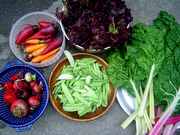

|
| Vegetable Varieties for Gardeners is a citizen science program
|
|
|
|
'Easter Egg' Radishes |
| |
| Sub-Category: |
Round
|
| |
|
| Sub-Category 2: |
| | Description: |
Open-pollinated. Round, red, purple and white roots mature over extended period. Resists bolting. About 30 days to maturity.
|
| Days To Maturity: |
30
|
| Seed Sources: |
Johnny's Selected Seeds - updated in 2016
|
| |
| Rating Summary |
| |
Overall: (3.4 Stars)
Taste: (3.6 Stars)
Yield: (4.0 Stars)
Ease/Reliability: (3.9 Stars) |
| |
| Reviews |
| |
Login to share your Review of Easter Egg.
Number of Reviews: 7
KEY: O=Overall Rating, T=Taste, Y=Yield, E=Ease
Reviewed on 10/18/2017 by
Debbie L
- An experienced gardener
|
 Overall Overall
 Taste Taste
 Yield Yield
 Ease Ease
|
Orange, New York, United States
Frost Free Season: 143 - 163 days
Soil Texture: Loam
Garden Size: Small - Less than 400 square feet (20' x 20')
Sun Exposure: More than 8 hours per day
|
| Varying germination rates. Nice flavor. Some cracking. |
| |
|
Reviewed on 10/05/2017 by
CCE Oneida County
- An intermediate gardener
|
 Overall Overall
 Taste Taste
 Yield Yield
 Ease Ease
|
Oneida, New York, United States
Frost Free Season: 163 - 183 days
Soil Texture: Loam
Garden Size: Medium - 400 square feet to 1,600 square feet
Sun Exposure: 6 to 8 hours per day
|
| Radish "Easter Egg" grew OK. Our wet weather gave them a watery taste/not a good flavor. |
| |
|
Reviewed on 07/07/2017 by
CCE Lewis
- A novice gardener
|
 Overall Overall
 Taste Taste
 Yield Yield
 Ease Ease
|
Lewis, New York, United States
Frost Free Season: 103 - 123 days
Soil Texture: Loam
Garden Size: Small - Less than 400 square feet (20' x 20')
Sun Exposure: 6 to 8 hours per day
|
| Size was good with all between 1"-2" in diameter, they were thinned twice before harvest. All four colors had a range of different flavors, red and pinks having a defined hot kick. We had some cracking. Took 30 days to mature. |
| |
|
Reviewed on 06/27/2017 by
Cutler Botanic Garden
- An experienced gardener
|
 Overall Overall
 Taste Taste
 Yield Yield
 Ease Ease
|
Broome, New York, United States
Frost Free Season: 163 - 183 days
Soil Texture: Loam
Garden Size: Large - More than 1,600 square feet (40' x 40')
Sun Exposure: More than 8 hours per day
|
| Planted seed 4/25/17. Harvested 6/20/17. Some splitting, but overall produced well. |
| |
|
Reviewed on 06/15/2017 by
Wayne County CCE
- An experienced gardener
|
 Overall Overall
 Taste Taste
 Yield Yield
 Ease Ease
|
Wayne, New York, United States
Frost Free Season: 103 - 123 days
Soil Texture: Loam
Garden Size: Small - Less than 400 square feet (20' x 20')
Sun Exposure: 6 to 8 hours per day
|
| Matured nicely. Had a zippy flavor. |
| |
|
Reviewed on 06/01/2014 by
JMac62
- An experienced gardener
|
 Overall Overall
 Taste Taste
 Yield Yield
 Ease Ease
|
Lake, Illinois, United States
Frost Free Season: 143 - 163 days
Soil Texture: Clay
Garden Size: Small - Less than 400 square feet (20' x 20')
Sun Exposure: More than 8 hours per day
|
| My 5-year old planted these in his garden this year with good success. Good size and shape, and colors were as advertised on packet. Radishes were predominately red, purple, pink. A few white, but I think those were late germinaters that I may have thinned out. Different colors seemed to germinate at different times, some a couple of weeks later than others. Some colors had fairly mild heat, others much hotter. |
| | | 1 of 1 gardener found this review helpful.
|
|
Reviewed on 12/12/2006 by
starwoodfarm
- An experienced gardener
|
 Overall Overall
 Taste Taste
 Yield Yield
 Ease Ease
|
Baker, Oregon, United States
Frost Free Season: Fewer than 103 days
Soil Texture: Clay
Garden Size: Large - More than 1,600 square feet (40' x 40')
Sun Exposure: More than 8 hours per day
|
| bye bye, nice knowing you. Not worth the hype. Not nearly as pretty as some others. They were much harder to sell too, I guess because it was hard to get that cleaned polished look. so bye |
| |
|
|
|
|
Vegetable Varieties for Gardeners is a citizen science program, © 2004-2024, All Rights Reserved
Cornell Garden Based Learning, Cornell University College of Agriculture & Life Sciences, Horticulture Section
|






 VVfG home
VVfG home
 Yield
Yield Overall
Overall